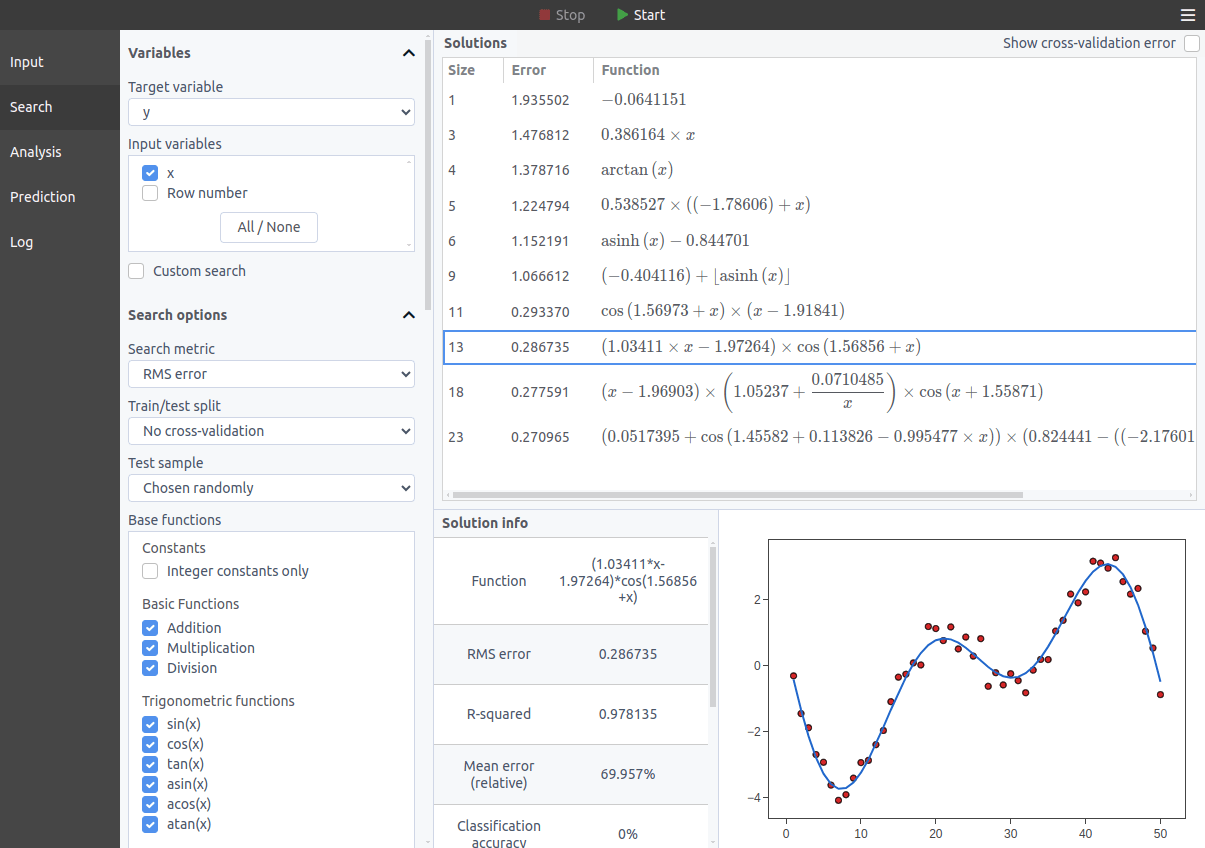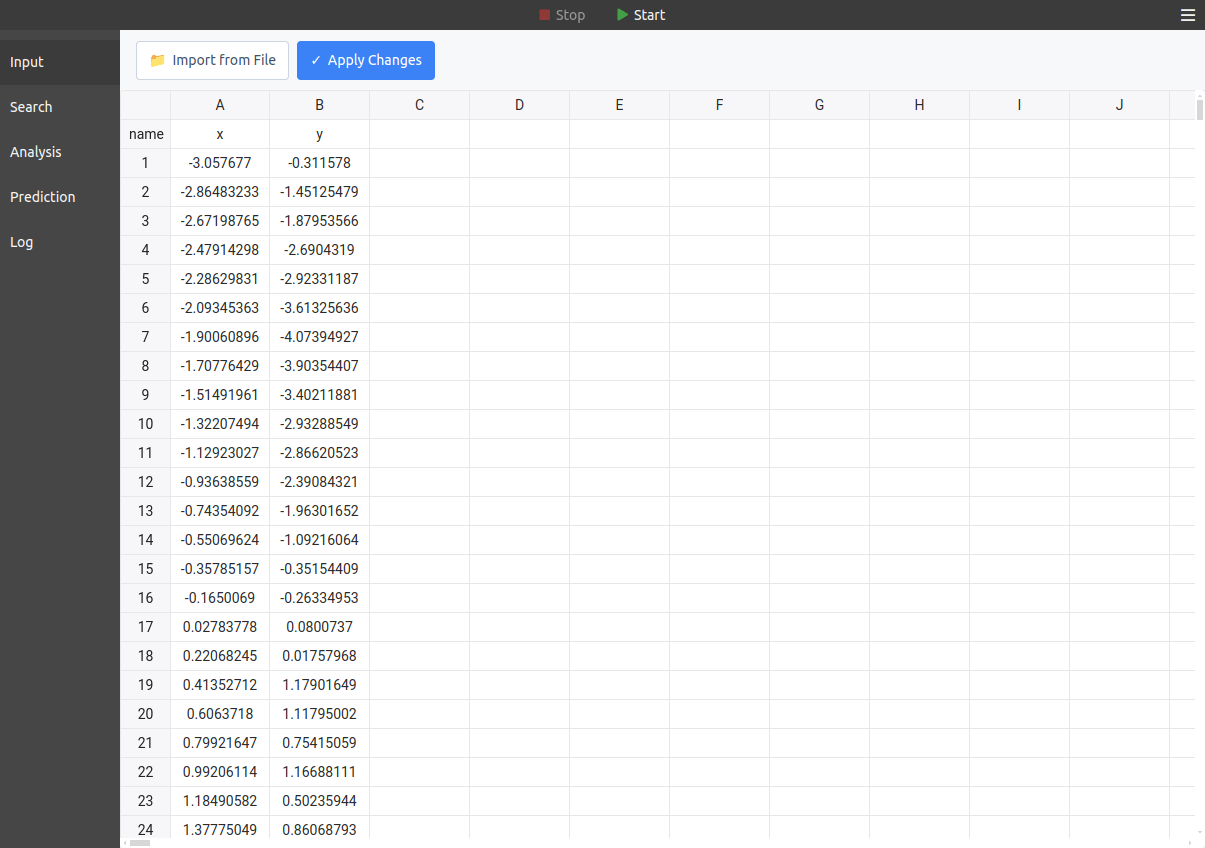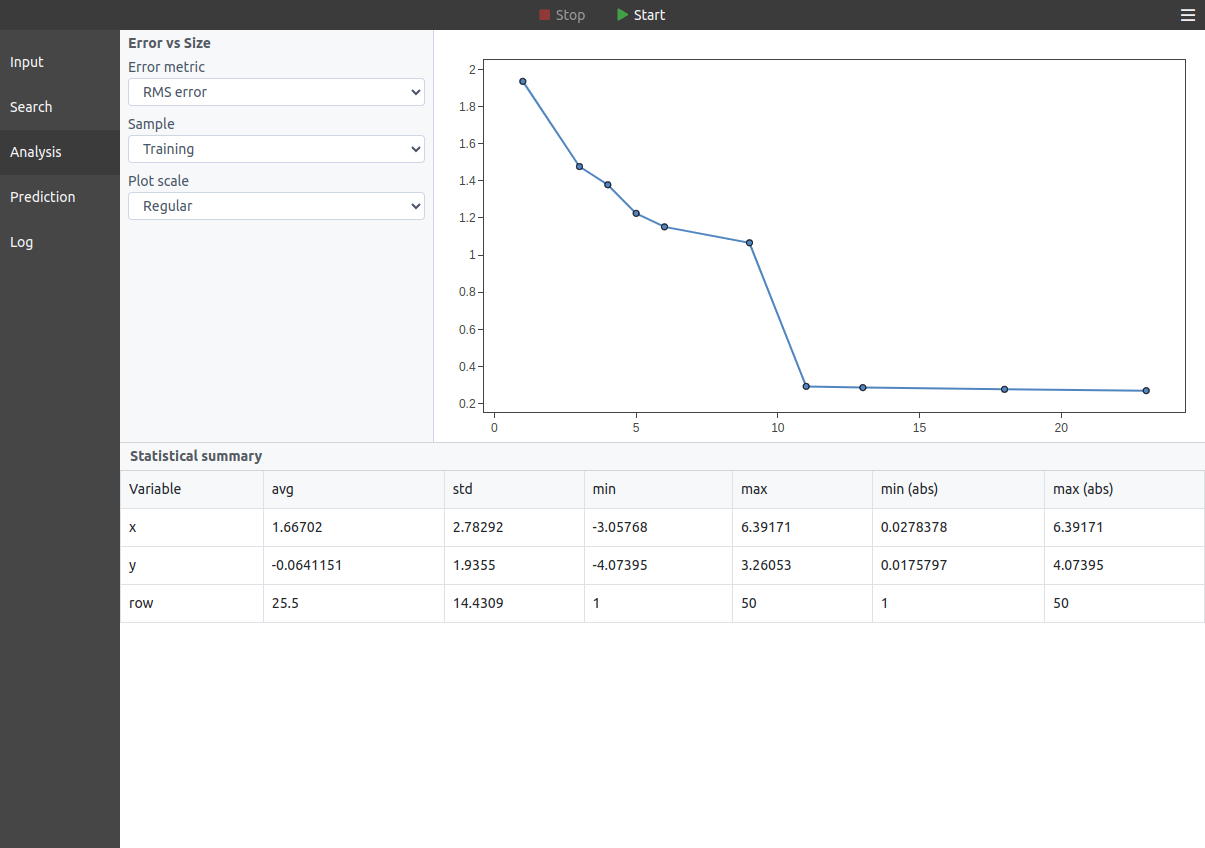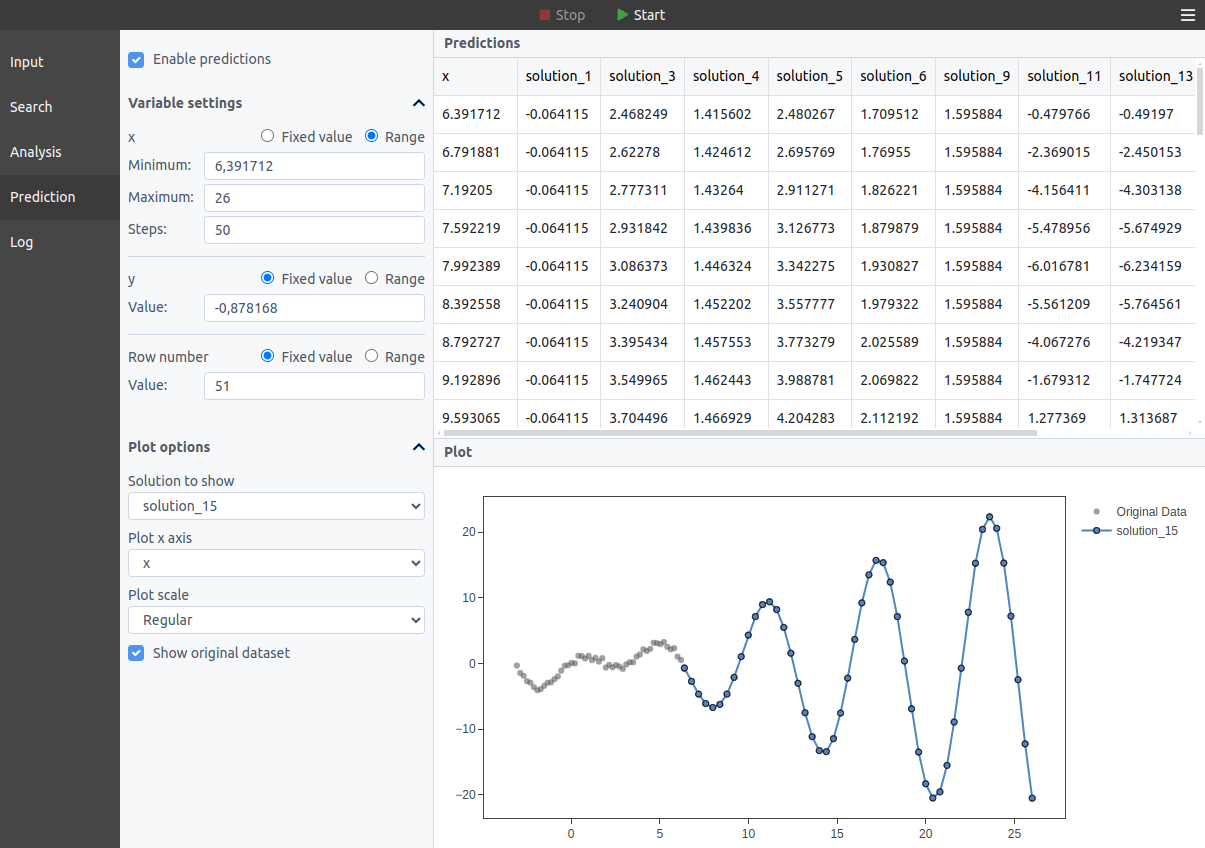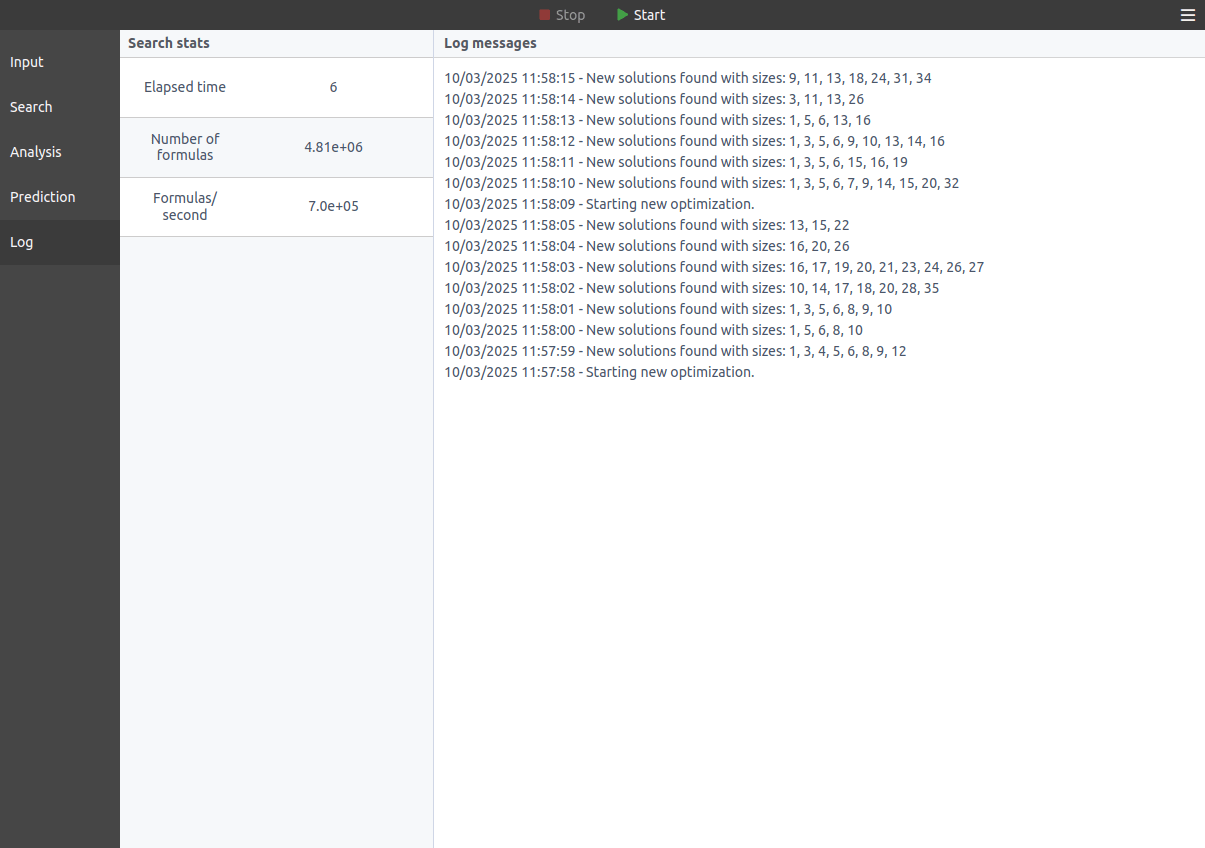Turn your data into formulas that actually make sense
Predicting numerical values from input variables can be challenging. Simple models like linear or polynomial regression often fail to capture complex patterns, while complex machine learning methods can be difficult to interpret and trust.
TuringBot uses symbolic regression to discover clear mathematical formulas that describe your data. The result: models that are accurate, robust, and explainable.
Given input variables like x and z, it can automatically find a relationship such as y = f(x,z).
How does it work?
TuringBot implements a technique called Symbolic Regression. It tries to combine a set of base functions into simple formulas that accurately predict a target variable as a function of one or more input variables. The base functions offered by the program are the following:
- Arithmetic: addition, multiplication, division
- Trigonometric: sin, cos, tan, asin, acos, atan
- Exponential: exp, log, log2, sqrt, pow
- Hyperbolic: sinh, cosh, tanh, asinh, acosh, atanh
- Logical: smaller, greater, equal, different, logical_or, logical_and
- History: delay, moving_average
- Other: abs, floor, ceil, round, sign, mod, gamma, erf
What is optimized is the formula itself, and not just the numerical constants of some assumed model.
The program uses TXT or CSV files as input, which may contain an arbitrary number of columns. It can be executed both interactively through its powerful graphical interface or in an automated way from the command line.
Here is an example of an input file that you can use: input.txt.
Why choose TuringBot?
- Proven track record: Our algorithm has been successfully employed in academic publications across a wide range of fields (see below).
- Easy setup: TuringBot is a simple executable that you can install in a few minutes. No Python dependencies, no Docker, no Conda, no virtual environments. This makes it easy to get started and focus on your work.
- Active development: TuringBot's development began in 2019, and version 1.0 was launched to the public in February 2020. Since then, the program has been continually updated in response to user feedback, introducing new features, optimizations, bug fixes, and quality-of-life improvements.
What can TuringBot be used for?
If your problem involves predicting a number as a function of other numbers, then you can apply TuringBot to it. Just save the data in TXT or CSV format, load it in the program, and start the search.
To give a few concrete examples:
- Predict the price of a house as a function of its characteristics (area, number of bedrooms, age, etc): A regression model example and how to generate it.
- Detect fraudulent credit card transactions based on anonymized features: Using Symbolic Regression to predict rare events.
Note that the second example is a classification problem. This is not an issue: just find formulas that output 0 or 1 depending on the category.
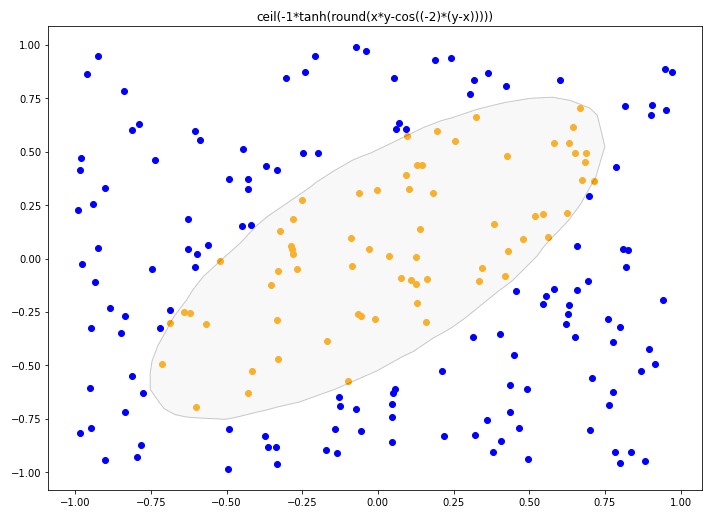
A decision boundary found with symbolic regression. Tutorial
What makes TuringBot so general is that many different search metrics are included, allowing models with different goals to be generated. Those include:
- RMS error
- Classification accuracy
- Correlation coefficient
- Maximum error
- Mean error
- Mean relative error
- Maximum relative error
- F-score
- Nash-Sutcliffe efficiency
- Binary cross-entropy
- Matthews correlation
Is TuringBot free?
TuringBot can be downloaded and used for free for as long as you want, but it also has a paid version that unlocks more functionalities. You can find more details on the Pricing page.
Is this like Eureqa?
Both TuringBot and Eureqa are implementations of Symbolic Regression, but the algorithms used by each are completely different. Eureqa is based on genetic programming, while TuringBot is based on Simulated Annealing.
Eureqa was acquired by a consulting company called DataRobot and is no longer commercially available.
A 2020 paper has shown that TuringBot performs noticeably better than Eureqa on a variety of Physics-inspired problems (arXiv:2010.11328). In this paper, TuringBot even managed to solve problems for which Eureqa could not find a solution at all.
Academic publications
Some publications that use TuringBot are:
- AI Descartes: Combining data and theory for derivable scientific discoveryCornelio, C., Dash, S., Austel, V., Josephson, T., Goncalves, J., Clarkson, K., ... & Horesh, L. (2021). arXiv preprint arXiv:2109.01634. [URL]
- From Kepler to newton: explainable AI for scienceLi, Z., Ji, J., & Zhang, Y. (2021). arXiv preprint arXiv:2111.12210. [URL]
- Study of air exchange and temperature efficiency in a room – based on parameter variations at the supply air vent for use with heated supply airSimensen, J. (2021). (Master's thesis, OsloMet-storbyuniversitetet). [URL, in Norwegian]
- Logic guided genetic algorithmsAshok, D., Scott, J., Wetzel, S. J., Panju, M., & Ganesh, V. (2021, May). (student abstract). In Proceedings of the AAAI Conference on Artificial Intelligence (Vol. 35, No. 18, pp. 15753-15754). [URL]
- An analytic BRDF for materials with spherical Lambertian scatterersd'Eon, E. (2021, July). In Computer Graphics Forum (Vol. 40, No. 4, pp. 153-161). [URL]
- Estimation of c* Integral for mismatched welded compact tension specimenKatinić, M., Turk, D., Konjatić, P., & Kozak, D. (2021). Materials, 14(24), 7491. [URL]
- Yield Load Solutions for SE (B) Fracture Toughness Specimen with I-Shaped Heterogeneous WeldKonjatić, P., Katinić, M., Kozak, D., & Gubeljak, N. (2021). Materials, 15(1), 214. [URL]
- A review of the fractal market hypothesis for trading and market price predictionBlackledge, J., & Lamphiere, M. (2021). Mathematics, 10(1), 117. [URL]
- Effect of the refrigerant charge, expansion restriction, and compressor speed interactions on the energy performance of household refrigeratorsKnabben, F. T., Ronzoni, A. F., & Hermes, C. J. (2021). International Journal of Refrigeration, 130, 347-355. [URL]
- Practical level-of-detail aggregation of fur appearanceZhu, J., Zhao, S., Wang, L., Xu, Y., & Yan, L. Q. (2022). ACM Transactions on Graphics (TOG), 41(4), 1-17. [URL]
- The SDSS-Gaia View of the Color–Magnitude Relation for Blue Horizontal-branch StarsBarbosa, F. O., Santucci, R. M., Rossi, S., Limberg, G., Pérez-Villegas, A., & Perottoni, H. D. (2022). The Astrophysical Journal, 940(1), 30. [URL]
- Semi-empirical equation for determination of stress concentration factors (SCF) in tubular joints of fixed offshore platforms subjected to axial forcesCosta, L. A., & de Sousa, J. R. M. (2022). In XLIII Ibero-Latin American Congress on Computational Methods in Engineering (Vol. 4, No. 04). [URL]
- Buckling Resistance of Single and Double Angle Compression MembersAlenezi, A. M. M. (2022). (Doctoral dissertation, Université d'Ottawa/University of Ottawa). [URL]
- Dynamic Economic Load Dispatch Using Linear Programming and Mathematical-Based ModelsAl-Subhi, A. (2022). Mathematical Modelling of Engineering Problems, 9(3). [URL]
- Identifying influential nodes with centrality indices combinations using symbolic regressionsMukhtar, M. F., Abas, Z. A., Rasib, A. H. A., Anuar, S. H. H., Zaki, N. H. M., Rahman, A. F. N. A., ... & Shibghatullah, A. S. (2022). International Journal of Advanced Computer Science and Applications, 13(5). [URL]
- Development of a Simple Method for Predicting Rice Biomass at Harvest Based on Biomass Accumulation DataTakeuchi Eisuke, Tanaka Yu, Yoshida Hiroe, Saito Kazuki, Katsura Keisuke, & Shiraiwa Tachihiko. (2022, September). In Proceedings of the 254th Japanese Society of Crop Science Conference (pp. 50-50). Japanese Society of Crop Science. [URL, in Japanese]
- Data-driven artificial intelligence (AI) algorithms for modelling potential maize yield under maize–legume farming systems in East AfricaAgboka, K. M., Tonnang, H. E., Abdel-Rahman, E. M., Odindi, J., Mutanga, O., & Niassy, S. (2022). Agronomy, 12(12), 3085. [URL]
- Novel machine-learning-based stall delay correction model for improving blade element momentum analysis in wind turbine performance predictionSyed Ahmed Kabir, I. F., Gajendran, M. K., Ng, E. Y. K., Mehdizadeh, A., & Berrouk, A. S. (2022). Wind, 2(4), 636-658. [URL]
- High-strain rate compressive behavior of fiber-reinforced rubberized concreteLai, D., Demartino, C., & Xiao, Y. (2022). Construction and Building Materials, 319, 125739. [URL]
- Approximating the Boundaries of Unstable Nuclei Using Analytic Continued FractionsMoscato, P., & Grebogi, R. (2023, July). In Proceedings of the Companion Conference on Genetic and Evolutionary Computation (pp. 751-754). [URL]
- Symbolic Regression Applied to Cosmology: An Approximate Expression for the Density Perturbation VarianceCarvalho, A., Oliveira, D. M., Krone-Martins, A., & Da Silva, A. (2023, October). In 2023 IEEE 19th International Conference on e-Science (e-Science) (pp. 1-2). IEEE. [URL]
- A Regression-Based Approach for Assessing the Buckling Coefficient of Stiffened and Unstiffened ElementsLakshmi, J. R., & Kumar, J. V. V. (2023, September). In IOP Conference Series: Earth and Environmental Science (Vol. 1237, No. 1, p. 012010). IOP Publishing. [URL]
- Machine learning based predictive modeling of stochastic systemsGajendran, M. K. (2023). University of Missouri-Kansas City. [URL]
- Multi-Method Simulation and Multi-Objective Optimization for Energy-Flexibility-Potential Assessment of Food-Production Process CoolingHoward, D. A., Jørgensen, B. N., & Ma, Z. (2023). Energies, 16(3), 1514. [URL]
- Influence of Open Differential Design on the Mass Reduction FunctionKarakašić, M., Konjatić, P., Glavaš, H., & Grgić, I. (2023). Applied Sciences, 13(24), 13300. [URL]
- Machine learning-based approach to wind turbine wake prediction under yawed conditionsGajendran, M. K., Kabir, I. F. S. A., Vadivelu, S., & Ng, E. Y. K. (2023). Journal of Marine Science and Engineering, 11(11), 2111. [URL]
- Continued fractions and the Thomson problemMoscato, P., Haque, M. N., & Moscato, A. (2023). Scientific Reports, 13(1), 7272. [URL]
- Galactic Archaeology through the Blue Stars of the Horizontal BranchBarbosa, F. O. (2023). (Doctoral dissertation, Universidade de São Paulo). [URL, in Portuguese]
- Forecasting Emergency Department Waiting Times Using Deep Neural NetworksPak, A., & Trinh, K. (2023). Value in Health, 26(12), S10. [URL]
- Machine Learning to Identify Atopic Dermatitis Prevalence Using Healthcare Utilisation Patterns of Both Diagnosed and Non-Diagnosed AD Patients Based on Danish Register DataLiljendahl, M., Torpet, M., Lyngsie, P. J., Rudolfsen, J. H., Pedersen, M., & Ibler, K. S. (2023). Value in Health, 26(12), S10. [URL]
- Finite Element Analysis and Machine Learning Guided Design of Carbon Fiber Organosheet-Based Battery Enclosures for CrashworthinessShaikh, S. A., Taufique, M. F. N., Balusu, K., Kulkarni, S. S., Hale, F., Oleson, J., ... & Soulami, A. (2024). Applied Composite Materials, 1-19. [URL]
- New postoperative pain instrument for toddlers—Secondary analysis of prospectively collected assessments after tonsil surgeryGude, P., Geldermann, N., Gustedt, F., Grobe, C., Weber, T. P., & Georgevici, A. I. (2024). Pediatric Anesthesia, 34(4), 347-353. [URL]
- The electron density at the midpoint of the plasmapauseDenton, R. E., Tengdin, P. M., Hartley, D. P., Goldstein, J., Lee, J., & Takahashi, K. (2024). Frontiers in Astronomy and Space Sciences, 11, 1376073. [URL]
- New alternatives to the Lennard-Jones potentialMoscato, P., & Haque, M. N. (2024). Scientific Reports, 14(1), 11169. [URL]
- Approximating the nuclear binding energy using analytic continued fractionsMoscato, P., & Grebogi, R. (2024). Scientific Reports, 14(1), 11559. [URL]
- Optimization and Comparative Evaluation of Novel Marine Engines Integrated with Fuel Cells Using Sustainable Fuel ChoicesSeyam, S., Dincer, I., & Agelin-Chaab, M. (2024). Energy, 131629. [URL]
- A New Approximation for the Perimeter of an EllipseMoscato, P., & Ciezak, A. (2024). Algorithms, 17(10), 464. [URL]
This list is constantly growing and is probably incomplete. If your paper is not shown, please email it to us and we will add it to the list.
Community
- TuringBot Forum: a growing community where you can get help, ask questions, and connect with others who are equally interested in the software.
Documentation
Check out the detailed documentation for the software, where you can find:
The documentation provides straightforward, easy-to-follow examples that will help you get started quickly.
Ready to get started?
Start discovering formulas from your data today.
